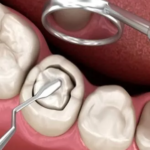What Are Toxic Dental Materials? Fillings, Braces, & More!

Toxic dental materials are various substances that dental professionals have been putting in mouths for years. In 2021, there is mounting evidence showing these substances exhibit cytotoxicity and other adverse effects on health.
What are fillings in teeth made of? The most common type of dental restoration, fillings in teeth are made of various materials like amalgam (mercury). Some fillings are made of porcelain, gold, glass ionomer, or a composite resin that satisfies biocompatibility standards.
Most people know that silver fillings are made with toxic dental materials (mercury), but other orthodontic materials like braces and sealants can contain toxic materials that you do not want in your mouth.
What is the safest dental filling material? The safest dental filling material is made of one of the following:
- Composite resin (BPA-free)
- Porcelain (AKA ceramic)
- Glass ionomer (fluoride-free)
Let’s dive into the most common toxic dental materials, starting with what’s really in your fillings, then revealing other toxic dental treatments.
TOXIC DENTAL FILLINGS
These 5 dental filling materials may be toxic:
- Dental amalgam fillings (mercury fillings)
- Composite resin fillings
- Glass ionomer fillings
- Resin-ionomer fillings
- Porcelain fused to metal fillings
Some are perfectly acceptable if certain ingredients are left out. But it is difficult to know exactly what is in a particular mixture of composite resin.
This is why it’s wise to go to a biological or functional dentist. They are not only concerned with your dental health, but also your overall health. A biological dental practice will ensure only non-toxic biomaterials are put in your mouth.
DENTAL AMALGAM FILLINGS (MERCURY)
Still the most common dental filling material, mercury fillings have been used for over 150 years in the US. Although the ADA (American Dental Association) claims they are safe, other global health organizations agree with the growing body of evidence showing that mercury fillings are toxic and dangerous.
Mercury fillings are also called:
- Amalgam fillings
- Dental amalgam fillings
- Mercury amalgam fillings
- Silver fillings
- Silver amalgam fillings
Amalgam fillings contain 50% mercury, by weight. Yes, mercury, a well-known toxic substance.
No wonder that mercury fillings are associated with mercury poisoning (mercury toxicity). In fact, the bodies of deceased patients with mercury fillings have 2-12 times the levels of mercury present in their skin than those without mercury fillings.
Mercury vapors from fillings are released most during placement and removal, but also when drinking hot drinks or acidic drinks, chewing, brushing your teeth, or grinding your teeth.
Also, dental amalgam expands and contracts with varying temperatures, possibly leading to fractures or cracking or damaging a nearby tooth.
Dental research has linked exposure to toxic mercury vapors in amalgam fillings with these 30 serious health problems:
- Allergic reactions
- Alzheimer’s disease
- Amyotrophic lateral sclerosis (ALS)
- Anxiety
- Appetite loss
- Autism spectrum disorders
- Autoimmune disorders
- Cardiovascular issues
- Chronic fatigue syndrome
- Depression
- Endocrine disruption
- Hallucinations
- Headaches
- Insomnia
- Kidney issues
- Liver issues
- Memory loss
- Multiple sclerosis
- Nervous system issues
- Oral cancer
- Oral lichen planus
- Parkinson’s disease
- Miscarriage or infertility
- Periodontal disease
- Respiratory issues
- Restless leg syndrome
- Suicidal thoughts
- Thyroid disorders
- Tremors
- Undesired weight loss















Leave a Reply